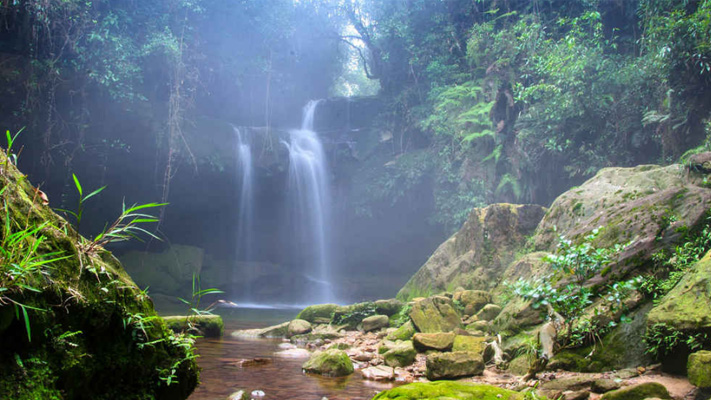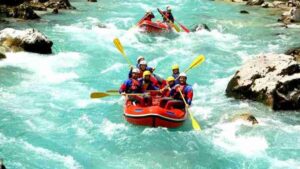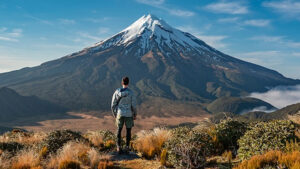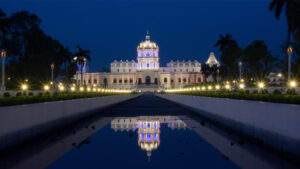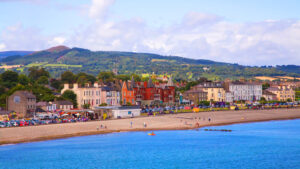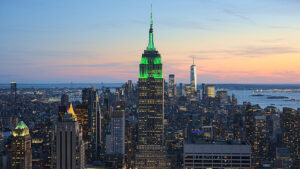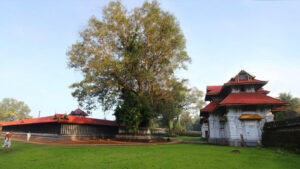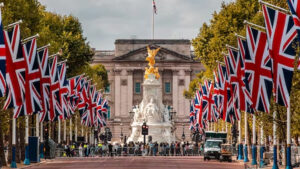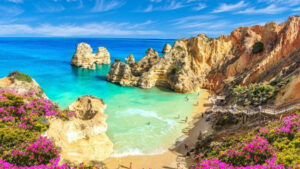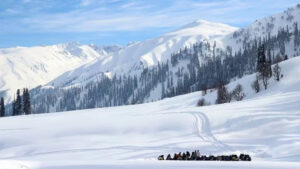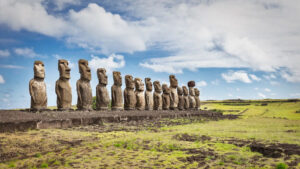LAITMAWSIANG, MEGHALAYA – THE ENCHANTING LAND OF WATERFALLS AND SACRED GROVES

Laitmawsiang is a small village located in the East Khasi Hills district of Meghalaya, a state in northeastern India. Meghalaya, which means “the abode of clouds” in Sanskrit, is known for its stunning landscapes, lush greenery, and rich cultural heritage.

Laitmawsiang is situated amidst the picturesque beauty of Meghalaya’s rolling hills and dense forests. It is renowned for its natural attractions, including waterfalls, caves, and trekking trails that draw tourists from all over the world.
One of the main attractions in Laitmawsiang is the Mawphlang Sacred Grove, which is considered a holy forest by the local Khasi community. The sacred grove is an ancient forest that has been preserved for centuries, and it is believed to be the dwelling place of their local deity, “Labasa.”
Laitmawsiang offers opportunities for adventure enthusiasts and trekkers. The village serves as a base for various treks, which take you through scenic landscapes, dense forests, and local villages.
Experiences and Activities Enjoyed by Tourists
Tourists visiting Laitmawsiang, Meghalaya, can enjoy a range of experiences and activities that showcase the natural beauty and cultural heritage of the region. Here are some of the popular activities enjoyed by tourists:

- Waterfall Exploration: Laitmawsiang is known for its stunning waterfalls, and tourists can visit the Laitmawsiang Waterfall and other nearby cascades. They can admire the breathtaking views, take photographs, and even take a refreshing dip in the natural pools beneath the falls.
- Trekking and Hiking: The village of Laitmawsiang serves as a starting point for various trekking trails, including the famous David Scott Trail. Tourists can embark on treks through lush forests, picturesque valleys, and remote villages, enjoying the serene surroundings and panoramic views along the way.
- Sacred Grove Visit: The Mawphlang Sacred Grove, located near Laitmawsiang, is a significant cultural and ecological site. Tourists can explore this ancient forest, which is considered sacred by the local community, and learn about the traditional beliefs and practices associated with it.
- Village Immersion: Laitmawsiang provides an opportunity to interact with the local Khasi community and experience their unique way of life. Visitors can engage in cultural exchanges, witness traditional ceremonies, learn about the Khasi traditions, and even participate in local activities such as weaving, farming, or cooking.
- Local Cuisine: Meghalaya is known for its unique culinary traditions, and tourists can savor the local Khasi cuisine in Laitmawsiang. Traditional dishes such as Jadoh (a rice and meat dish), Dohneiiong (pork cooked with black sesame), and various bamboo shoot preparations are popular choices.
- Camping and Nature Retreats: For those seeking a closer connection with nature, camping and nature retreats are popular options. Visitors can set up campsites amidst the pristine surroundings, enjoying the tranquility of the forests and the starry nights.
Top Attractions and Must Visit Places
In addition to Laitmawsiang village itself, there are several top attractions and must-visit places in and around the area of Meghalaya. Here are some of them:

- Shillong: The capital city of Meghalaya, Shillong, is a vibrant and picturesque destination. It offers attractions such as the Ward’s Lake, Shillong Peak, Don Bosco Centre for Indigenous Cultures, and the lively Police Bazaar. Shillong is also known for its music scene and hosts the annual NH7 Weekender music festival.
- Cherrapunji: Located about 50 kilometers from Laitmawsiang, Cherrapunji is famous for being one of the wettest places on Earth. It boasts stunning waterfalls like Nohkalikai Falls and Seven Sisters Falls, as well as the living root bridges of Nongriat village, which are an engineering marvel made from tree roots.
- Mawlynnong: Dubbed as “Asia’s cleanest village,” Mawlynnong is a scenic village known for its cleanliness and eco-friendly practices. Visitors can explore the living root bridge here, along with beautifully maintained gardens and panoramic views from the Sky View Tower.
- Dawki: Located near the India-Bangladesh border, Dawki is renowned for its crystal-clear river, the Umngot River. Tourists can enjoy boating in transparent boats and witness the mesmerizing beauty of the river, surrounded by lush green landscapes.
- Nongkhnum Island: Situated in the West Khasi Hills district, Nongkhnum Island is the largest river island in Meghalaya. It offers a peaceful retreat with sandy beaches, serene riverbanks, and opportunities for boating and fishing.
- Mawphlang: As mentioned earlier, Mawphlang is home to the Mawphlang Sacred Grove, which is a must-visit for its cultural and ecological significance. The sacred grove is a preserved forest with unique plant species, ancient trees, and mystical ambiance.
- Elephant Falls: Located on the outskirts of Shillong, Elephant Falls is a three-tiered waterfall that cascades down the rocks amidst lush greenery. It is a popular tourist spot known for its natural beauty and is easily accessible from Laitmawsiang.
- Limestone Caves: Meghalaya is known for its intricate network of limestone caves. Some of the famous caves in the region include Mawsmai Cave, Krem Mawmluh, and Krem Dam. These caves offer a fascinating experience for adventure seekers and nature enthusiasts.
Shopping and Cuisine
Shopping:

- Local Handicrafts: Meghalaya is known for its intricate handicrafts made by skilled artisans. Visitors can explore local markets and shops in places like Shillong and purchase items such as bamboo and cane products, traditional handwoven textiles, tribal jewelry, and unique wooden crafts.
- Traditional Attire: The traditional attire of the Khasi, Garo, and Jaintia tribes in Meghalaya is colorful and distinctive. Visitors can buy traditional garments like the Jainsen (a wraparound skirt for women) and the Dhara (a traditional garment for men) to experience the local culture.
- Traditional Musical Instruments: Meghalaya has a rich musical heritage, and traditional musical instruments like the Duitara (a string instrument), the Ksing (a bamboo mouth organ), and the Tangmuri (a flute) are popular among locals and tourists alike. These instruments can be found in local markets and shops.
- Souvenirs: Visitors can find an array of souvenirs in Meghalaya, such as keychains, fridge magnets, T-shirts, and postcards featuring local attractions and cultural motifs. These can be great mementos to take back home.
Cuisine:
- Jadoh: Jadoh is a traditional Khasi dish made with rice and meat (usually pork) cooked with a blend of spices and served with a side of fermented soya bean paste. It is a popular and flavorful dish in Meghalaya.
- Dohneiiong: Dohneiiong is a traditional Garo pork curry prepared with black sesame seeds and a mixture of spices. It has a rich and distinctive taste.
- Tungrymbai: Tungrymbai is a fermented soybean dish that is popular among the Khasi and Jaintia communities. It is often cooked with pork and has a unique and tangy flavor.
- Dohkhlieh: Dohkhlieh is a traditional Meghalayan salad made with diced pork, onions, green chilies, ginger, and various herbs and spices. It is known for its spicy and tangy taste.
- Pumaloi: Pumaloi is a traditional Garo rice dish cooked with vegetables and flavored with herbs and spices. It is often served during special occasions and festivals.
- Tea: Meghalaya is known for its tea gardens, and visitors can enjoy a cup of locally grown tea, whether it’s black tea, green tea, or herbal infusions. Tea plantations in places like Sohryngkham offer scenic views and a chance to learn about tea production.
- Local Sweets: Meghalaya offers a range of delightful sweets like Godoh Garem (sticky rice pudding), Pukhlein (rice flour fritters), and Tungtap (a sweet made from fermented soybeans).
Best Time to Visit
The best time to visit Meghalaya, including Laitmawsiang, depends on various factors such as weather, events, and festivals. Here are the key considerations for planning your visit:
- Weather: Meghalaya experiences a moderate climate throughout the year, but the region is known for its heavy rainfall. The monsoon season, which lasts from June to September, brings abundant rainfall and can make travel challenging. Therefore, it is generally advisable to avoid visiting during the peak monsoon season.
The ideal time to visit Meghalaya is during the drier months from October to May when the weather is more pleasant for outdoor activities and sightseeing. The months of October to November and February to April are particularly favored by tourists due to the mild temperatures and clear skies.
- Festivals and Events: Meghalaya is known for its vibrant festivals and cultural events. Some of the notable festivals celebrated in the region are:

- Wangala Festival (November): It is a harvest festival celebrated by the Garo tribe with traditional music, dance performances, and vibrant costumes. The festival takes place in various locations, including Tura, which is not far from Laitmawsiang.
- Shad Suk Mynsiem (April): This is a major cultural festival of the Khasi tribe held in Shillong. It involves traditional dances, music, and rituals, showcasing the rich heritage of the Khasi community.
- Behdienkhlam Festival (July): Celebrated by the Jaintia tribe, this festival involves a unique ritual where participants carry bamboo poles to drive away evil spirits. It is held in Jowai, which is a short distance from Laitmawsiang.



